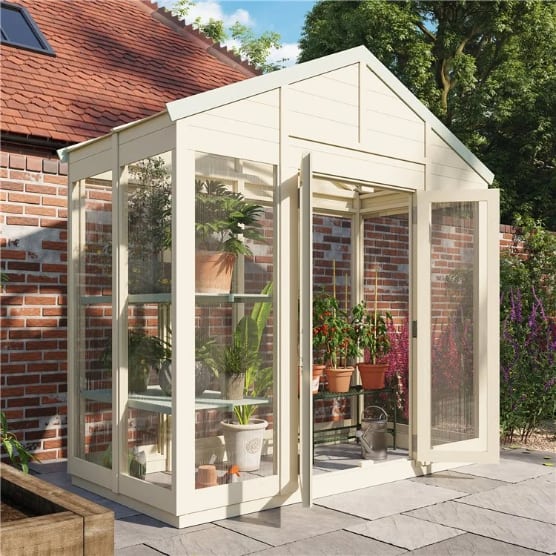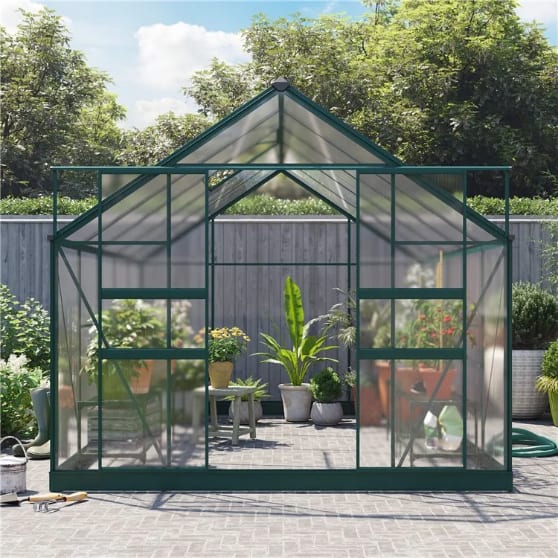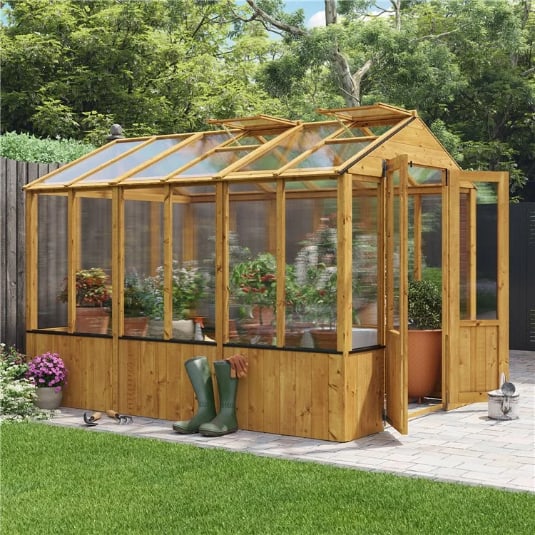Jump to:
Starting your own greenhouse is an exciting project that allows you to grow plants in a controlled environment, regardless of the weather. Whether you’re a seasoned gardener or completely new to gardening, setting up a greenhouse can be a highly rewarding experience. In this guide, we’ll walk you through all the essential steps of starting a greenhouse, from initial planning to installing a solid foundation, managing temperature and humidity, and creating the ideal environment for your plants to thrive.
Check out our Greenhouse Buying Guide to explore the different types of greenhouses available, perfect for beginners.
Choosing the Right Greenhouse Location

The first and most important step in starting a greenhouse is choosing the right location. The position of your greenhouse will affect how well it performs throughout the year, so it’s important to make an informed choice. Look for a spot that gets plenty of sunlight – ideally, your greenhouse should receive at least 6–8 hours of direct sunlight each day. This is especially critical during the colder months, as the sunlight will help regulate the temperature inside the greenhouse.
In addition to sunlight, accessibility is another important factor to consider. Choose a location that’s easy to access for regular maintenance and watering. Make sure the ground is flat to prevent water from pooling inside the greenhouse, and avoid areas prone to strong winds that could cause damage to your structure. Additionally, consider proximity to water sources for easy irrigation.
To learn more, read this guide: How Much Sunlight Does a Garden Greenhouse Need?
Selecting the Right Greenhouse Type
Once you’ve chosen the perfect location, it’s time to select the type of greenhouse that suits your needs. There are three main types of greenhouses to consider:
Lean-to Greenhouse: This type is attached to an existing building, making it an excellent choice for smaller spaces. It’s also easy to access and is generally more affordable.
Free-standing Greenhouse: This standalone structure can be placed anywhere on your property. It’s ideal if you have more space and want to maximize your growing area.
Mini Greenhouse: Perfect for gardeners with limited space or those looking to grow a small amount of plants, mini greenhouses are a cost-effective option.
Each type has its own advantages depending on your available space, budget, and growing needs. It’s important to choose one that aligns with your goals for growing plants.
Browse our garden greenhouses collection to see options that fit your space and budget
Understanding Greenhouse Foundations

A solid foundation is one of the key elements to successfully starting a greenhouse. The foundation ensures your greenhouse is stable, helps with drainage, and prevents weeds from overtaking your growing space. Depending on your greenhouse type and budget, there are several foundation options to choose from.
A gravel foundation is one of the most common and cost-effective options. A 2-4 inch layer of gravel provides excellent drainage and is easy to maintain. If you prefer a more permanent structure, a concrete slab foundation offers durability and is particularly useful for larger greenhouses. However, it can be more costly and time-consuming to install. A wooden frame foundation works well for smaller greenhouses or temporary setups. It’s important to make sure your foundation is level and slightly sloped to allow water to drain away from the greenhouse.
Alternatively, you can opt for a quick-fit base kit. It’s a ready-to-use foundation system that, once placed on the ground and interlocked, forms a solid, level surface for your greenhouse to sit on. A great example is the Ecobase Fastfit Foundation Base, which requires no assembly service.
Planning for Temperature and Humidity Control

Temperature and humidity are crucial factors in the success of your greenhouse. Without proper temperature control, your plants may struggle to grow, especially in extreme weather conditions. It’s important to plan for both heating and ventilation to create a comfortable environment for your plants.
More basic greenhouse setups in areas without much harsh weather might be fine with just opening the door every so often to balance out the temperature and internal moisture levels. However, in particularly hot or humid times of year, or if you’re growing more sensitive plants, some extra ventilation features can be extremely useful.
Ventilation is key to keeping the air inside your greenhouse fresh and preventing the buildup of excessive heat. Installing vents in the roof and sides will allow for proper airflow, which helps to regulate temperature and humidity. If you live in a colder climate, you may need to invest in a greenhouse heater to maintain optimal growing conditions during winter months. Propane or electric heaters are popular options, depending on your preference and greenhouse size.
Maintaining the right humidity levels is equally important. Too much moisture can lead to mold, while too little can cause your plants to dry out. Consider installing a misting system or humidity trays to maintain proper moisture levels. Shading may also be necessary in hotter climates to protect plants from excessive heat. Shade nets are an affordable and effective way to prevent your greenhouse from getting too warm during the summer.
Setting Up Your Greenhouse Interior
Once your greenhouse structure is in place, it’s time to think about how you’ll set up the interior. The interior layout should be designed with efficiency in mind, allowing you to make the most of your space while ensuring easy access to your plants.
Start by installing shelves and benches for growing plants in containers. Ensure these are sturdy and spaced out properly to allow good airflow around your plants. For larger greenhouses, raised beds are an excellent choice as they provide better soil drainage and make it easier to manage your plants.
Watering is an essential part of greenhouse care. If you plan to water manually, make sure you have a reliable watering system, such as hoses or watering cans. Alternatively, installing a drip irrigation system ensures your plants are watered consistently and efficiently, reducing water waste. Drip systems deliver water directly to the roots, which helps to keep the soil evenly moist without over-watering.
Watering and Irrigation Systems
Watering your greenhouse plants efficiently is crucial to their success. A drip irrigation system is a great option for greenhouses, as it delivers water directly to the root zone of the plants, minimizing water waste. This system is ideal for larger greenhouses where you may have many plants to water at once. Another option is using overhead sprinklers, which can also work well for larger greenhouses but require careful management to avoid excessive moisture buildup, which could lead to mold or mildew.
If you have a smaller greenhouse, manual watering using watering cans or hoses may be sufficient. Just make sure you monitor moisture levels regularly to ensure your plants are getting the water they need. Additionally, you could consider rainwater harvesting to reduce water costs and use more sustainable options.
Regular Greenhouse Maintenance and Troubleshooting
Regular maintenance is key to keeping your greenhouse in good condition and ensuring your plants stay healthy. Start by checking the structure periodically for any leaks, cracks, or wear and tear, especially after severe weather. You should also inspect the ventilation system to make sure that vents open and close properly, allowing for adequate airflow. If your greenhouse is equipped with a heating system, make sure it’s functioning correctly during colder months.
Pest control is another important part of greenhouse maintenance. Regularly inspect your plants for signs of pests and diseases. If you notice any problems, act quickly to treat them with organic solutions like neem oil or introduce beneficial insects to help keep pests at bay.
And that’s it for our greenhouse setup guide! These are just some of the ways you can set up your greenhouse and get off to a great start. If your garden space allows it, you might as well add a small potting shed to keep your essentials in one place.
Not bought a greenhouse yet? Check out our greenhouse buying guide for all the advice you need.
For maintenance, give this guide a read next: Garden Greenhouse Cleaning Guide





